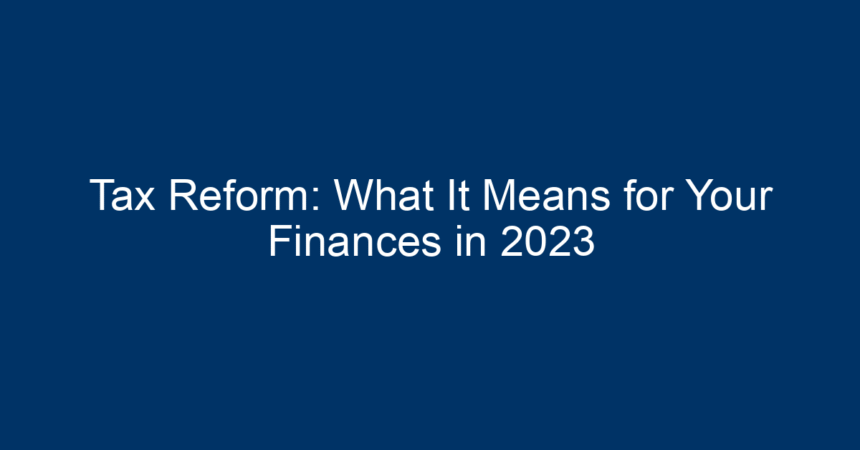Tax reform is a topic that captures the attention of countless individuals and businesses across the United States. As we dive into 2023, navigating the complexities of tax law is more crucial than ever. Understanding these changes can significantly impact your finances, whether you’re a salaried employee, a business owner, or a retiree. This article delves into what tax reform entails, its implications for various financial scenarios, and how you can strategize to maximize your benefits.
What is Tax Reform?
Tax reform refers to the changes made to the tax laws governing how individuals and businesses calculate their tax liabilities. These reforms can include alterations to tax rates, deductions, credits, and definitions of taxable income. The purpose of tax reform is usually to simplify the tax code, promote economic growth, and ensure a fairer distribution of the tax burden.
The Landscape of Tax Reform in 2023
For 2023, the significant tax reforms include adjustments to tax brackets, alterations in deductions, and new regulations surrounding credits. These changes result from ongoing policy discussions aimed at increasing revenue and addressing budget deficits.
Key Changes in Tax Rates
One of the most impactful aspects of tax reform is the change in tax rates. The IRS typically adjusts tax brackets annually to account for inflation. For 2023, the tax rate structure for individuals remains progressive, which means that higher income levels are taxed at higher rates.
2023 Tax Brackets:
- 10%: Up to $11,000 (single) or $22,000 (married filing jointly)
- 12%: $11,001 to $44,725 (single) or $22,001 to $89,450 (married)
- 22%: $44,726 to $95,375 (single) or $89,451 to $190,750 (married)
- 24%: $95,376 to $182,100 (single) or $190,751 to $364,200 (married)
- 32%: $182,101 to $231,250 (single) or $364,201 to $462,500 (married)
- 35%: $231,251 to $578,125 (single) or $462,501 to $1,000,000 (married)
- 37%: Over $578,125 (single) or over $1,000,000 (married)
Staying updated with these brackets can significantly influence financial planning strategies, especially for high earners.
Changes in Deductions and Credits
Several deductions and credits have either been modified or introduced to reflect the needs of taxpayers in 2023.
Standard Deduction
The standard deduction has seen an increase this year, which reduces the taxable income for many taxpayers. For 2023, the standard deduction is:
- $13,850 for single filers
- $27,700 for married couples filing jointly
This increase allows more individuals to benefit from higher deductions, significantly impacting taxable income.
Itemized Deductions
Despite some limitations on itemized deductions, a few categories have remained unchanged, including:
- Mortgage interest deduction, which allows homeowners to write off interest paid on their mortgage.
- State and local tax deduction (SALT), capped at $10,000, continues to affect those living in high-tax states.
Implications for Businesses
Tax reform doesn’t just affect individuals; businesses face updates as well. In 2023, specific deductions and credits have been modified, including:
- Deduction for Qualified Business Income (QBI): Business owners might qualify for a 20% deduction on certain types of income, which will require savvy accounting to maximize benefits.
- Bonus Depreciation: The temporary bonus depreciation provisions, grounded in prior tax reforms, allow businesses to deduct a significant percentage of an asset’s cost upfront. In 2023, bonus depreciation is set at 80%, helping small businesses invest in growth.
Retirement Contributions and Tax Benefits
In 2023, retirement plan contributions have been bolstered in several ways. The IRS has raised the contribution limits for various retirement accounts:
- 401(k) plans: The limit has increased to $22,500 (up from $20,500).
- IRA contributions: The limit is now at $6,500 for individuals under 50, with catch-up contributions remaining unchanged at $1,000 for those 50 and older.
These increases allow individuals to save more for retirement while taking advantage of tax-deferred growth, making effective financial planning for retirement more critical.
Impact on Capital Gains and Dividends
Tax reform often affects how capital gains and dividends are taxed. For most taxpayers in 2023, long-term capital gains remain at 0%, 15%, or 20%, depending on taxable income levels. Understanding the implications of capital gains tax codes can help taxpayers strategize on asset generalization and investment timing.
Charitable Contributions
For those inclined to give back, charitable contributions remain a tax-deductible expense, but it’s critical to keep documentation for any gifts. In 2023, taxpayers can still deduct contributions, provided they itemize their deductions.
Actionable Insights for 2023 Tax Filing
- Maximize Deductions: Consider whether itemizing or taking the standard deduction is more beneficial for your situation.
- Plan Retirement Contributions Appropriately: Take advantage of the increased contribution limits for retirement accounts.
- Stay Informed on Legislative Changes: Since tax laws can change, staying updated on relevant legislation will ensure you are prepared for future tax obligations.
- Consult a Tax Professional: If you are unsure how these tax reforms may affect you, consulting a tax professional can provide personalized guidance.
- Document Everything: Keep thorough records of all financial transactions, especially those related to deductions and credits, to simplify the filing process.
Conclusion
2023 brings a landscape of tax reforms that can significantly influence your financial situation. Understanding these changes—from tax rates to deductions and retirement contributions—can empower you to make informed decisions that optimize your tax liability.
As you prepare for file your taxes, remember that proactive planning is the key to maximizing benefits while minimizing liabilities. Stay informed, keep diligent records, and consider seeking expertise to navigate this complex yet crucial aspect of personal finance.
By staying proactive and informed about tax reform, you can make the most of your finances in 2023 and beyond.




